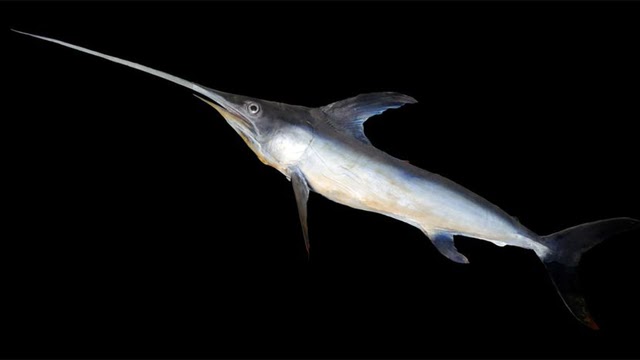Quck answer
Swordfish are powerful and agile predators that are capable of reaching speeds of up to 60 miles per hour. They have long, narrow bills that they use to slash and stun their prey, which includes squid, octopus, and other fish. Despite their size and strength, swordfish are also known for their intelligence and adaptability. They are able to navigate through complex ocean environments and use their keen senses to locate and capture their prey. Additionally, swordfish are prized by fishermen for their meat, which is considered a delicacy in many parts of the world. Overall, swordfish are truly the natural-born gladiators of the sea.
Wild Animals

Some animals have unique physical features that make them stand out. Narwhals, axolotls, aye ayes, goblin sharks, and long-wattled umbrella birds are just a few examples. The swordfish, with its meter-long saber-like bill, is no exception. However, this unusual feature serves a purpose and is a result of evolution.
Swordfish: A Special Species
The swordfish (Xiphias gladius) is a type of billfish, a predatory pelagic fish that includes sailfish, marlin, and spearfish. Swordfish are incredibly athletic due to their gills, which have a high surface area and can absorb more oxygen than most fish. They can grow up to 14 feet in length and weigh up to 1,200 pounds. Swordfish inhabit a wide range of temperatures and depths, from the surface to over 3,280 feet. They are known to forage around the clock, using their unique physiology to their advantage.
Swordfish: Natural-Born Gladiators
Swordfish use their bill to stun and immobilize their prey before swallowing it whole. They are top predators with exceptional eyesight, allowing them to forage in low light conditions and follow their prey vertically and horizontally in the water column. Swordfish are truly the gladiators of the open ocean.
Swordfish possess regional endothermy, a characteristic found in open sea fish which enables them to maintain the temperature of specific parts of their body higher than the surrounding water temperature. This ability allows them to keep those parts of their body active that require a high temperature, even in frigid waters, such as their eyes, brains, and muscles responsible for prolonged swimming. By doing so, swordfish remain fierce predators even in low temperatures that may slow down their prey. They can also endure temperature changes of more than 27 degrees F (15 degrees C) within minutes. While other fish such as tuna and some shark species exhibit a greater capacity for regional muscle endothermy than swordfish, they cannot sustain such long and fast dives down the water column.
Furthermore, swordfish can travel long distances, with a migration range of up to 3,100 miles (5,000 kilometers) one way and returning to the same location the following year. According to Sepulveda, swordfish migrations can span from the equator to high latitudes (50В°N and 50В°S), and their exceptional temperature tolerance allows them to inhabit some of the most productive habitats on earth. It is rare for open sea fish to withstand temperature changes exceeding 36 degrees F (20 degrees C) daily, but new tagging technology is enabling researchers to document their movements for the first time. Recent data is revealing the incredible abilities of these predators.
Interestingly, Aristotle named the swordfish 2,400 years ago, using both the Greek and Roman words for “sword,” “xiphias” and “gladius.”
FAQ
1. What makes swordfish such formidable predators?
Swordfish are known for their speed, agility, and strength, making them one of the most formidable predators in the ocean. Their long, sword-like bill, or rostrum, is a powerful weapon that they use to stun and impale their prey. They can also swim at incredibly high speeds, reaching up to 60 miles per hour, making them one of the fastest fish in the ocean. Additionally, swordfish have excellent vision, allowing them to spot prey from a great distance.
2. What do swordfish typically eat?
Swordfish are opportunistic feeders and will eat a variety of prey, including squid, octopus, mackerel, and other fish. They are known to hunt both near the surface and in deep waters, using their speed and strength to catch their prey.
3. How do swordfish reproduce?
Swordfish reproduction is unique in that they are oviparous, meaning that they lay eggs. Females can produce up to 1 million eggs per year, which are fertilized by males during spawning season. The eggs hatch into larvae, which eventually grow into adults.
4. Are swordfish endangered?
Swordfish populations have been overfished in some areas, leading to concerns about their conservation status. However, regulations have been put in place to limit commercial fishing and protect swordfish populations. As a result, swordfish populations have shown signs of recovery in some areas.
5. What are some interesting facts about swordfish?
Swordfish are known for their unique anatomy and behavior. For example, their body temperature is higher than the surrounding water, allowing them to swim faster and more efficiently. They also have a unique circulatory system that helps to conserve heat and oxygen. Additionally, swordfish have been known to leap out of the water, a behavior known as breaching, which is thought to help them dislodge parasites or communicate with other swordfish.
6. Can swordfish be eaten?
Yes, swordfish is a popular seafood choice in many parts of the world. However, it is important to be aware of the potential health risks associated with consuming swordfish, as they can contain high levels of mercury. It is recommended that pregnant women and young children limit their consumption of swordfish and other large predatory fish.





Leave a Reply